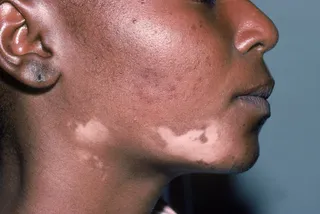The 411 on Vitiligo
How does this skin condition affect Blacks?

1 / 11
Understanding Vitiligo - Recently, it was announced that Chantelle Brown-Young, one of the Black female contestants in this summer’s edition of America’s Next Top Model, has vitiligo. But what exactly is this skin condition? Read more about what vitiligo is and how it affects African-Americans.— Kellee Terrell (Photo: Chantelle Brown-Young via Instagram)

2 / 11
What Is It? - Vitiligo is a disease where the pigment in your skin is destroyed and leaves behind patches of white skin on your body. These white patches can also appear in the tissues inside the nose and mouth, the inner layer of someone’s eyes and turn one’s hair white. It’s very rare for the pigment to come back once it’s been destroyed.(Photo: GettyImages)

3 / 11
What Causes Vitiligo? - Doctors are not sure, but some believe that vitiligo may be a result from an autoimmune disease that would cause the body to attack its own pigment. Other theories include it being a genetic disorder or that it’s triggered by stress or the environment. (Photo: Thomas Barwick/Getty Images)

4 / 11
How Common Is It? - Vitiligo is pretty rare, affecting almost 2 percent of the U.S population, and it doesn’t discriminate — it affects people of all races and genders equally. Vitiligo only appears to affect people of color more because the signs are more obvious among darker skin. (Photo: GettyImages)

5 / 11
When Does It Show Up? - This disease differs in different people and can stay dormant for years. But 95 percent of people will show signs before they turn 40, with 50 percent showing signs before they turn 20, says Web MD. (Photo: LEO RAMIREZ/AFP/Getty Images)
ADVERTISEMENT

6 / 11
How Does It Appear? - Vitiligo occurs in three different ways. Focal pattern is when the depigmentation isn’t wide spread or happens in a few areas in the body. Segmental pattern is when the patches occur on one side of the body. And generalized, which is the most common, happens equally on both sides of the body. (Photo: John MD/GettyImages)

7 / 11
It May Be in the Genes - Having a family history of vitiligo can increase your chances of having the disease. Past studies have shown that kids with parents who have the disease have a 30 percent higher chance of developing the disease as well. (Photo: John MD/GettyImages)
Photo By Photo: John MD/GettyImages

8 / 11
Other Risk Factors - Vitiligo is also associated with people who have other autoimmune disorders, such as overactive thyroids, patches of baldness (alopecia) and premature hair graying. (Photo: JGI/Jamie Grill/Blend Images)

9 / 11
Treatment Options - There is no cure or treatment to prevent vitilgo. What doctors can do is help to improve the areas that have been affected with make up, creams, skin grafting and a method called re-pigmentation. Treatments may take a long time and there is a chance that they may not work, the NIH points out. (Photo: Getty Images)

10 / 11
Coping With the Stigma - Watching your appearance change over time can be frustrating and depressing, which is why seeking counseling and support groups are extremely helpful in processing one’s disease. Whether you choose to use make up to cover up your spots is completely up to you. (Photo: laflor/Getty Images)
Photo By Photo: laflor/Getty Images
